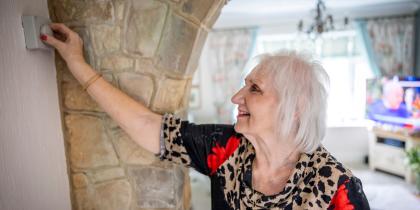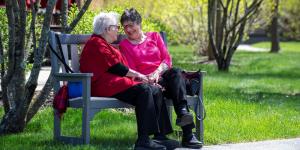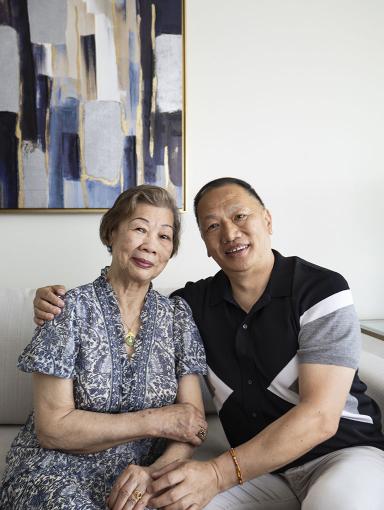Climate Change and Heat Resilience in Older Adults
Learn how individuals and communities can take steps to adapt to rising temperatures

The many impacts of climate change on our planet, such as rising sea levels, extreme weather events, and disrupted ecosystems, are well-documented. While these hazards aren’t good news for anyone, older adults are especially vulnerable to the increase in the intensity and frequency of climate-related events.
That’s an area that Amir Baniassadi, PhD, a post-doctoral research fellow at Hebrew SeniorLife’s Harvard Medical School-affiliated Hinda and Arthur Marcus Institute for Aging Research, is committed to continuously learning more about. He was named a 2023 STAT Wunderkind for his research focusing on the health and well-being of older adults within the built environment.
Dr. Baniassadi recently co-authored an editorial in the Journal of Gerontology, Medical Sciences, that explores the challenges older adults are facing due to rising temperatures and offers strategies to become more heat resilient on the individual, community, and societal levels.
A new climate reality is here
Climate change has made it so weather once considered extreme is now becoming the new norm, with a steady stream of news headlines announcing record-breaking temperatures and natural disasters. In fact, 6,500 daily U.S. heat records were broken in summer 2023 in cities and towns across the nation.
Making the problem worse is the fact that urban areas experience the “heat island” effect, meaning they have higher temperatures than surrounding rural areas. This is largely caused by the fact that structures like buildings and roads absorb and re-emit heat from the sun more than natural landscapes like trees and grass.
With so many of these structures and far fewer natural landscapes, temperatures in cities are higher than in their outlying areas. The nonprofit research group Climate Central found that 41 million people in the U.S. live in heat islands where temperatures are elevated by at least 8 degrees Fahrenheit.
Older adults and heat vulnerability
Older adults are particularly sensitive to higher temperatures. Over 80% of the 12,000 people who die per year in the U.S. of heat-related causes are over the age of 60.
What makes older adults more vulnerable? Age-related physiological changes mean that older adults can experience more difficulty in body temperature regulation, cardiovascular functions, and maintaining balanced fluid levels, which is important for hydration. Health problems like Type 2 diabetes and certain medications can make it more difficult for the body to manage heat. Age-related disease and cognitive impairments can pose problems too, as some older adults may not notice that they’re overheating. If they don’t notice, they won’t know that they need to take steps to cool off.
“There are many age-related diseases, for example, or medications that older adults use for diseases that diminish their thermal perception. Imagine a 90-year-old sitting in their room and it’s 90 degrees in that room. They may not perceive it, but their body is not okay — it’s straining their heart and cardiovascular system,” explained Dr. Baniassadi.
Socioeconomic factors play a factor in heat vulnerability too. For example, people who come from lower-income backgrounds are more likely to live in homes prone to overheating and are less likely to have access to resources like air conditioning. If they do have air conditioning, they might not be able to afford increased electrical bills and maintenance.
The built environment and heat resilience
The built environment also plays an important role in fighting (or exacerbating) heat exposure. The built environment is exactly what it sounds like — the environment and structures that humans have built. That includes buildings, roads, bridges, transportation systems, and more.
According to Dr. Baniassadi, many buildings in today’s cities were constructed without a changing climate in mind. Given today’s rising temperatures, that’s becoming a problem. “The climate is changing, and our housing cannot compete with the pace of how the climate has changed,” he explains.
For example, a lot of the homes in cities with colder environments were designed to be airtight and highly insulted to keep heat in during the winter. But with sweltering summers potentially becoming the new norm — the summer of 2023 was the planet’s hottest since global records began in 1880, according to NASA — trapping heat inside isn’t always a good thing.
Having a working air conditioner is one way to make the temperature inside a house more heat resilient. Other building characteristics, such as materials used in the walls and the amount of shade, can also affect indoor temperature. But air conditioning isn’t the only or best answer — it’s expensive and it’s not great for the environment.
Dr. Baniassadi’s research shows that a heat-resilient built environment is one adaptive strategy for heat resilience, which would call for “reconsidering our architectural designs, especially in subsidized housing, and creating a cooler urban environment through strategies such as reflective rooftops and increased vegetation cover.” He has conducted research performing energy simulations to test the benefits of a new “super cool” roof coating material, finding that it has the potential to fight urban heat by staying significantly cooler than conventional white roofs.
“If your objective is to maximize energy efficiency, the way you design a home may deviate from the way that you would design the home if you wanted to make it survivable for people,” he explained. “All of this has been fine historically, because they did all of this with the former climate in mind . . . but it's not like that anymore,” he added.
Creating a personal adaptive strategy
Understanding and facing the challenges head-on can pave the way for effective heat mitigation and climate resilience. Here are some strategies you can keep in mind to keep yourself cool:
- Drink enough water. While 72 ounces is a good general starting point, everyone’s needs are different and can be dependent on health conditions and other factors. If you are over 60 or have any underlying medical conditions, it’s best to check with your primary care provider to learn how much water you should drink.
- Dress to stay cool. Moisture-wicking fabrics can help your body regulate temperature. Cooling towels, personal misters, and fans can also help you stay cool during a hot day.
- Consider your diet. Water-rich foods like fruits and vegetables help with hydration, while caffeine and alcohol do the opposite.
- Consider your sleep environment. The optimal sleep temperature for seniors is between 68 to 77 degrees Fahrenheit. If you’re sleeping in an overheated bedroom, your sleep becomes less efficient, which can impact your health. Light, breathable bed linens and blackout curtains can help you keep your bedroom cool.
- Stay informed. Pay attention to local weather forecasts so you can plan your daily activities accordingly if it’s going to be hot.
Collective action can make a difference
It’s more than just a personal responsibility. Communities, families, and health care providers have a role to play, too, in helping older adults adapt to climate change. Family members and neighbors can check in on older adults in the community to make sure they have the resources they need to stay comfortable, especially if they have decreased mobility or cognitive impairments.
Meanwhile, health care providers can integrate screenings for heat-related risks into check-ups, offer tailored advice, and disseminate information about the effects of medications during high-temperature periods.
Sustainability is at the heart of Hebrew SeniorLife communities
Hebrew SeniorLife has already made enormous strides in prioritizing sustainability, with affordable housing new construction in Brookline, Dorchester, and Randolph designed to meet Passive House standards. Passive House, a performance-based building certification that focuses on dramatic energy use reduction for heating and cooling, is one of the world’s most proven approaches to energy reduction, assured indoor air quality, durability, and thermal comfort. Through Passive House, Hebrew SeniorLife delivers healthier and more comfortable communities to live in and establishes the fundamental building block of resiliency: safe and reliable shelter.
Additionally, Hebrew SeniorLife’s Sustainability Committee, which consists of residents and staff across every campus, have worked together to expand the organization’s environmental stewardship, spearhead sustainability projects, and explore ways for the communities to become even more resilient in the face of climate change. For example, members of the committee led or participated in projects to renovate existing buildings for improved energy efficiency. Hebrew SeniorLife is also taking steps to apply the Marcus Institute’s research to foster more resilient communities.
Exploring senior living options in Massachusetts?
Hebrew SeniorLife offers a variety of senior living communities in the Boston area for people of all income levels and abilities, including independent living, supportive senior living, assisted living, and long-term chronic care. We likely have the ideal choice for you or your loved one. Furthermore, our communities are actively engaged in the effort to fight climate change through sustainability efforts and ensure comfortable air temperatures all year round.
If you’re interested in learning more, we’re here to assist you in making the right decision. Reach out to us at 781-859-3090 or connect with us online.
Blog Topics
Learn More
Research on Aging
At the Hinda and Arthur Marcus Institute for Aging Research, Harvard Medical School-affiliated researchers are working to uncover answers to some of the most pressing challenges of aging.





